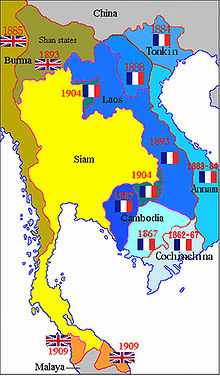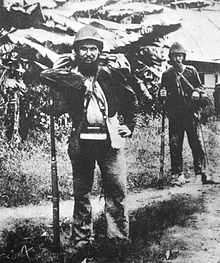Franco-Siamese War
| Franco-Siamese War (1893) | |||||||||
|---|---|---|---|---|---|---|---|---|---|
 French ships Inconstant and Comète under fire in the Paknam incident, July 13, 1893 |
|||||||||
|
|||||||||
| Belligerents | |||||||||
| Commanders and leaders | |||||||||
| |||||
The Franco-Siamese War of 1893 was a conflict between the French Third Republic and the Kingdom of Siam. Auguste Pavie, French vice consul in Luang Prabang in 1886, was the chief agent in furthering French interests in Laos. His intrigues, which took advantage of Siamese weakness in the region and periodic invasions by Vietnamese rebels from Tonkin, increased tensions between Bangkok and Paris. Following the conflict, the Siamese agreed to cede Laos to France, an act that led to the significant expansion of French Indochina.
Context


The conflict started when French Indochina’s Governor-General Jean de Lanessan sent Auguste Pavie as consul to Bangkok to bring Laos under French rule. The government in Bangkok, mistakenly believing that they would be supported by the British government, refused to concede territory east of the Mekong and instead reinforced their military and administrative presence.[1]
Events were brought to a head by two separate incidents when Siamese governors in Khammuan and Nongkhai expelled three French merchants from the middle Mekong in September 1892, two of them, Champenois and Esquilot, on suspicion of opium smuggling.[1][2] Shortly afterwards, the French consul in Luang Prabang, Massie, feverish and discouraged, committed suicide on his way back to Saigon.[1][2] Back in France, these incidents were used by the colonial lobby (Parti Colonial) to stir up nationalistic anti-Siamese sentiment, as a pretext for intervention.[2][3]
The death of Massie left Auguste Pavie as the new French Consul. In March 1893 Pavie demanded that the Siamese evacuate all military posts on the east side of the Mekong River south of Khammuan, claiming that the land belonged to Vietnam. To back up these demands, the French sent the gunboat Lutin to Bangkok, where it was moored on the Chao Phraya next to the French legation.
Conflict
When Siam rejected the French demands, de Lanessan sent 3 military columns into the disputed region to assert French control in April 1893. 8 small Siamese garrisons west of the Mekong withdrew upon the arrival of the central column, but the advance of the other columns met with resistance: in the north, the French came under siege on the island of Khoung, with the capture of an officer, Thoreaux; while in the south, the occupation proceeded smoothly until an ambush by the Siamese on the village of Keng Kert resulted in the killing of French police inspector Grosgurin.[4]
Killing of Inspector Grosgurin
Inspector Grosgurin was a French inspector and commander of a Vietnamese militia in Laos. Like the French explorer and diplomat Auguste Pavie, he had been engaged in several exploratory expeditions in the region.[5][6] He was a member of one of the French armed columns despatched in April 1893 by de Lassenan to cross the Annamite Range into the Laos area of Khammuan (modern Thakhek)[7] and to occupy the disputed territory. The column was at first successful in evicting the Siamese commissioner at Khammuan by May 25.[5][6]
Shortly afterwards on June 5, the Siamese commissioner organized a surprise ambush on the village of Kien Ket, where Grosgurin, confined to his sickbed, had encamped with his militia.[5][6] The commissioner had apparently been instructed by Siamese government representatives to "compel their [French troops] retirement, by fighting, if necessary, to the utmost of their strength" .[7][8] The ambush resulted in the razing of the village and the killing of Grosgurin and 17 Vietnamese.[8]
The incident and the death of Grosgurin became known as the "Affair of Kham Muon (Kien Chek)" and was ultimately used as a pretext for the strong French intervention.[7][9]
Paknam incident
As a result, relations between Bangkok and the West soured, with France demanding reparations. The British sent in 3 navy ships to the mouth of the Chao Phraya, in case evacuation of British citizens became necessary.[1] In turn the French went one step further in July 1893 by ordering two of their ships, the sloop Inconstant and the gunboat Comète, to sail up the Chao Phraya towards Bangkok, without the permission of the Siamese: they came under fire from the fort at Paknam on July 13, 1893.[10] The French returned fire and forced their way to Bangkok.[7]
With guns trained on the Grand Palace in Bangkok, the French delivered an ultimatum to the Siamese on July 20 to hand over the territory, to withdraw their garrisons there, to pay an indemnity of two million francs in reparation for the fighting at Paknam, and to punish those responsible for the killings in the disputed territory.[7] When Siam did not immediately comply unconditionally to the ultimatum, the French blockaded the Siamese coast.[7]
In the end the Siamese submitted fully to the French conditions, finding no support from the British.[3] In addition, the French demanded as guarantees the temporary occupation of Chantaburi and the demilitarisation of Battambang, Siemreap and a 25 kilometre-wide zone on the western bank of the Mekong.[7] The conflict led to the signature of the Franco-Siamese Treaty, on October 3, 1893.[7]
Franco-Siamese trial
Following the killing of Grosgurin, the Commissioner of the Kammuon District, Phra Yot, was acknowledged by his government to have been the responsible official, although was he initially acquitted of wrongdoing in a trial in March 1894.[8][11] A "Franco-Siamese Mixed Court" was subsequently convened in June 1894.[8] The court determined that Phra Yot had brought extra forces to surround the house in Kien Ket occupied by the ill Grosgurin, outnumbering his small Vietnamese militia; that Grosgurin and those Vietnamese who had not managed to escape had been killed and the house subsequently set on fire on the orders of Phra Yot.[9][12]
In a joint agreement between the Siamese and the French, Phra Yot was condemned to 20 years of penal servitude.[8] The solicitor for the defense was the Ceylonese lawyer William Alfred Tilleke, who was later appointed Attorney General of Siam and granted a peerage by the king.[9][13][14] The Royal Thai Army fort Phra Yot Muang Khwan in Nakhon Phanom Province on the border between Thailand and Laos commemorates Phra Yot.[14]
Consequences

The Siamese agreed to cede Laos to France, an act that led to the significant expansion of French Indochina. In 1896, France signed a treaty with Britain that defined the border between Laos and the British territory in Upper Burma. The Kingdom of Laos became a protectorate and was initially placed under the Governor General of Indochina in Hanoi. Pavie, who almost single handedly brought Laos under French rule, saw to the officialization in Hanoi.
The French and the British both had strong interests in controlling parts of Indochina. Twice in the 1890s, the French and British were on the verge of war over two different routes leading to Yunnan. Two major difficulties stopped these two powers from war. The first was the geography of the land made it difficult to move troops efficiently and therefore would have made waging a war very costly and most likely ineffective. The second factor that kept the two countries apart was that they were both fighting a very difficult battle within their respective countries. Malaria was common and deadly. The routes that the two countries were interested in never really came into use. In 1904 the French and the British put aside their differences with the Entente Cordiale of 1904, which ended their dispute over routes in southern Asia.
Gallery
-

Siamese army in Laos in 1893
-

Siamese Elephant-mounted artillery in Laos in 1893
-
_bf_1923.jpg)
The French gunboat Comète (1884-1909)
-
.jpg)
The gunboat Lutin (1877-1897) was stationed in central Bangkok in March 1893
Notes
- ↑ 1.0 1.1 1.2 1.3 Stuart-Fox 1997
- ↑ 2.0 2.1 2.2 ''The Kingdoms of Laos'' by Peter Simms, p.206-207. Books.google.com. 2001-06-29. Retrieved 2012-02-03.
- ↑ 3.0 3.1 Ooi 2004
- ↑ Dommen 2001, p. 18
- ↑ 5.0 5.1 5.2 de Pouvourville, Albert (1897), L'affaire de Siam, 1886-1896, Chamuel
- ↑ 6.0 6.1 6.2 The Indochinese Experience of the French and the Americans by Arthur J. Dommen p.18
- ↑ 7.0 7.1 7.2 7.3 7.4 7.5 7.6 7.7 The Kingdoms of Laos Peter Simms, p.207
- ↑ 8.0 8.1 8.2 8.3 8.4 The Peoples and Politics of the Far East (1895) by Sir Henry Norman, p.480-481
- ↑ 9.0 9.1 9.2 "The Case of Kieng Chek Kham Muon before the Franco-Siamese Mixed Court. Constitution of the Mixed Court and rules of procedure". Archive.org. Retrieved 2012-02-03.
- ↑ ''Commerce in War'' by Llewellyn Archer Atherley, p.182. Books.google.com. Retrieved 2012-02-03.
- ↑ "archive". New York Times. Retrieved 2012-02-03.
- ↑ "archive". New York Times. Retrieved 2012-02-03.
- ↑ "Official history of Tilleke & Gibbons". Tillekeandgibbins.com. Retrieved 2012-02-03.
- ↑ 14.0 14.1 Loos, Tamara (2006), Subject Siam: Family, Law, and Colonial Modernity in Thailand, Cornell University Press, pp. 59–60, ISBN 0-8014-4393-8
References
- "Anglo-French Rivalry in Southeast Asia: Its Historical Geography and Diplomatic Climate" by John L. Christian
- Chandran Jeshurun, "The Contest for Siam 1889 - 1902: A Study in Diplomatic Rivalry", Kuala Lumpur: Penerbit Universiti Kebangsaan Malaysia, 1977.
- Stuart-Fox, Martin (1997), A History of Laos, Cambridge University Press, pp. 24–25, ISBN 0-521-59746-3
- Ooi, Keat Gin (2004), Southeast Asia: A Historical Encyclopedia, from Angkor Wat to East Timor, ABC-CLIO, pp. 1015–1016, ISBN 1-57607-770-5, "Paknam Incident(1893)"
- Tuck, Patrick J. N. (1995), The French Wolf and the Siamese Lamb: The French Threat to Siamese Independence, 1858-1907, White Lotus, ISBN 974-8496-28-7
- Andrew, C. M.; Kanya-Forstner, A. S. (1971), "The French 'Colonial Party': Its Composition, Aims and Influence, 1885-1914", The Historical Journal 14: 99–128, doi:10.1017/S0018246X0000741X, JSTOR 2637903
- Dommen, Arthur J. (2001), The Indochinese Experience of the French and the Americans: Nationalism and Communism in Cambodia, Laos, and Vietnam, Indiana University Press, ISBN 0-253-33854-9
External links
| Wikimedia Commons has media related to Franco-Siamese War. |
| ||||||||||||||
| ||||||||||||


